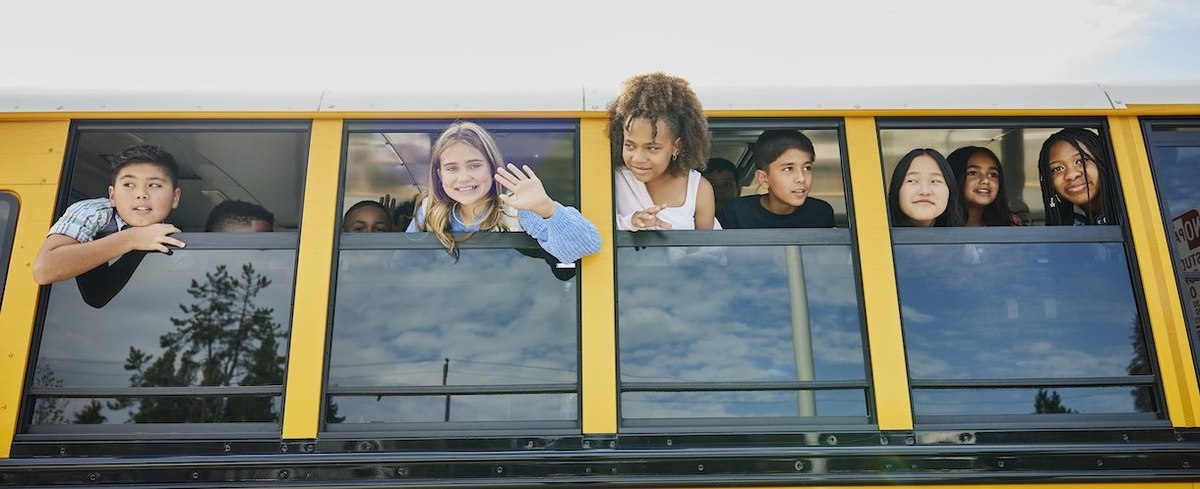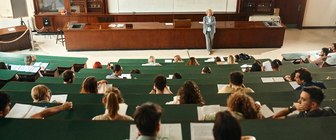As schools around the country begin opening for the year ahead, a new YouGov poll asked Americans about the issues facing public education in the U.S. today, proposals for teacher shortages, and whether public schools should provide free meals for students. Most Americans think public schools in their area do a good job, but majorities are concerned about bullying, unmet learning objectives, and depression and anxiety among students in their local public schools.
About three-quarters (74%) of Americans attended public schools for their entire K-12 education. Americans are slightly more likely to say the public schools in the U.S. do a very or somewhat good job than a very or somewhat bad job (49% vs. 43%). Republicans are about twice as likely as Democrats to say public schools in the country do a bad job (57% vs. 26%).
Americans view their local schools more favorably than they do the nation's schools. 54% say the public schools in their area do a very or somewhat good job; 35% say they do a very or somewhat bad job. Democrats are more likely than Republicans to say their local public schools do a good job (68% vs. 51%).
82% of Americans are very or somewhat concerned about bullying in the public schools in their local area. About as many are concerned about students not meeting learning objectives (79%) and about depression and anxiety among students (78%). Majorities also are concerned about funding shortages (74%), violence (73%), teacher shortages (72%), and a lack of parent involvement (69%).
Republicans are far more likely than Democrats to be concerned about students in their local public schools being indoctrinated with liberal ideas (82% vs. 19%). They also are at least twice as likely to be concerned about the availability of inappropriate books (57% vs. 24%) and about too much access to classroom technology (48% vs. 23%).
Democrats are more likely than Republicans to be concerned about the banning of books in their local public schools (81% vs. 53%), students being indoctrinated with conservative ideas (59% vs. 34%), and funding shortages (86% vs. 65%).
Among parents of students in grades K-12, the most common concerns about public schools in their local area are bullying (85% are very or somewhat concerned), students not meeting learning objectives (81%), and depression and anxiety among students (77%). Parents of K-12 students are less likely than Americans overall to say they are concerned about a lack of access to classroom technology (41% vs. 54%) and the banning of books (57% vs. 65%).
The share of Americans who are concerned about sexual abuse in their public schools has fallen since August 2023, to 64% from 73%.
One-third (34%) of Americans — including 41% of parents of K-12 students — think there is a shortage of K-12 teachers in their local area. Democrats are about twice as likely as Republicans to say there is a teacher shortage in their area (41% vs. 22%).
By far, the most popular idea for alleviating teacher shortages among the nine included in the survey is paying teachers more. Net support for paying teachers more — the share of Americans who strongly or somewhat support each idea minus the share who oppose it — is +66. 74% of Americans support this idea and 8% oppose it.
Negative net support for reducing the school week from five days to four days (-13), incentivizing more parents to homeschool their children (-20), and increasing taxes on local residents to fund schools (-25) indicate that opposition outweighs support for these ideas. The idea with the lowest net support (-76) is paying teachers less: Only 4% support this and 81% oppose it.
Among Democrats, the most ideas with the highest net support are paying teachers more (+90) and increasing taxes on local residents to fund schools (+2). Among Republicans, the ideas with the highest net support are paying teachers more (+47) and incentivizing more parents to home-school their children (+8).
Among parents of K-12 students, the ideas viewed most favorably are paying teachers more (+71 net support) and reducing the school week from five days to four days (+4). Among people who either are teachers themselves or have a close friend or family member who is, the idea of paying teachers more has net support of +69 — roughly the same as among parents of K-12 students.
29% of Americans think that public schools should provide free breakfast, lunch, and dinner for all students. 56% think they should provide free breakfast for all students; 30% say they should provide this for low-income students only. 58% think public schools should provide free lunch for all students and 31% think this should be for low-income students only. 30% think public schools should provide free dinner for all students and 30% say they should only do this for low-income students.
Democrats are more likely than Republicans to say schools should provide all students with free breakfast (67% vs. 44%), free lunch (72% vs. 44%), and free dinner (37% vs. 22%).
As students return to school, how are parents feeling? Among parents of K-12 students, 50% say they’re usually very or somewhat happy when summer ends and children return to school in the fall. 23% say they’re usually neither happy nor sad and 22% say they’re usually sad.
34% of Americans say that when they were a child and summer ended, they usually felt happy about going back to school. 25% said they usually felt neither happy nor sad, and 38% say they usually felt sad.
Related:
- Crushes, cliques, and classes: What most Americans remember about high school
- Who should decide what's included in K-12 public school curriculums?
- Education: What 2024 voters want and which candidate they trust
See the results for this YouGov survey
— Carl Bialik and Taylor Orth contributed to this article
Methodology: This article includes results from an online survey conducted August 6 - 8, 2025 among 1,073 U.S. adult citizens. Respondents were selected from YouGov’s opt-in panel to be representative of adult U.S. citizens. The sample was weighted according to gender, age, race, education, 2024 presidential vote, 2020 election turnout and presidential vote, baseline party identification, and current voter registration status. 2024 presidential vote, at time of weighting, was estimated to be 48% Harris and 50% Trump. Demographic weighting targets come from the 2019 American Community Survey. Baseline party identification is the respondent’s most recent answer given around November 8, 2024, and is weighted to the estimated distribution at that time (31% Democratic, 32% Republican). The margin of error for the overall sample is approximately 4%.
Image: Getty
What do you really think about President Trump, American politics in general, and everything else? Share your reality, join the YouGov panel, and get paid to share your thoughts. Sign up here.













